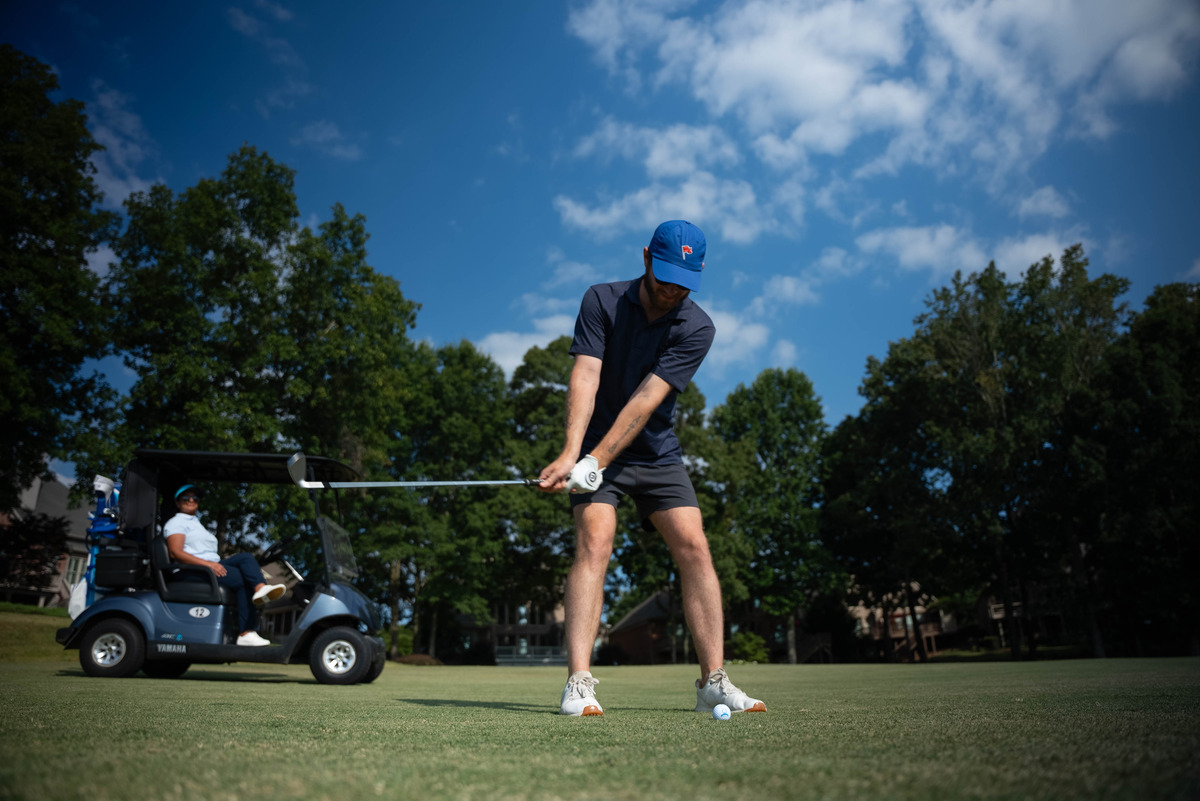
Golf has always had barriers to entry: access, cost, difficulty, etc. But thanks to grassroots initiatives, cultural changes and pandemic-fueled participation, the game has gotten younger, more diverse and more inclusive in recent years. That said, pace of play in golf is one barrier that’s become more imposing, even as others have fallen away.
Packed tee sheets, newcomers, bad actors, scant understanding and enforcement of the rules and equipment changes—golf’s pace of play problem has a number of causes, both recreationally and professionally. So what can we do about it?
With participation in a healthy spot, addressing the pace of play in golf must be a massive priority, not only to break down barriers for newcomers, but also to retain the loyal weekend players and diehards who represent the lifeblood of the industry.
Let’s dive in.
- What is pace of play in golf?
- Why is pace of play in golf so important to address?
- Slow play by the numbers
- Can courses help to improve pace of play in golf?
- How can golfers improve the pace of play in golf?
Discover 2025 golf trends
Dive into the whys and hows behind golf's participation boom and how you can better appeal to golfers in 2025 and beyond.
What is pace of play in golf?
Pace of play in golf is the time it takes to play a round of golf, usually 9 or 18 holes. It takes into consideration the wait time between each shot on any given hole, as well as the wait time between each hole played.
The general rule of thumb is that an 18-hole round of golf should take between 4 and 4 1/2 hours. For this goal to be achieved, many factors come into play, which we will discuss shortly.
Maintaining an efficient pace of play is a collective responsibility that falls to:
- Golf course owners and operators
- Golfers
- Marshals and starters
- PGA professionals and instructors
- Golf’s governing bodies
The disconnect between studying slow play and policing it
Pace of play in golf is an extremely complex issue that organizations like the USGA and the R&A have studied at length for decades.
Their goal? To create a body of resources, tips and best practices that golf operators can reference in building their own pace of play policy.
Of course, creating a knowledge base on a subject and enforcing it at the level of individual groups of golfers are very difficult things.
So while the knowledge and technology to combat slow play exist, it’s up to individual courses and players to actually enact changes at the grassroots level.
Why is pace of play in golf so important to address?
At its core, golf’s pace of play problem directly impacts customer satisfaction and the golfing experience your facility provides.
One awfully slow round could lead a group of golfers to take their business elsewhere; a summer season full of multiple slow rounds at multiple facilities could lead the members of that group to sour on the game, play less, be less inclined to introduce others to golf and so on.
Let’s take a look at some major issues with slow play and why the pace of play in golf is so important to address.
1. Golf is supposed to be a respite, not a chore
A recent survey by Lightspeed found the top three reasons 18-44 year olds play golf are:
- Time spent outdoors: 52%
- Mental health and self care: 48%
- Social activity: 48%
This crucial age demographic (Gen Z and Millennials) turn to golf to find joy, respite and escape both alone and with loved ones.
In this context, a busy course with glacial pace of play is sure to frustrate, distract many of these golfers, alienating them from the reasons they wanted to play in the first place.
Regardless of how much you love being outdoors on a beautiful golf course, nobody likes 5+ hour rounds, waiting on every single shot and contending with slow play that could have otherwise been avoided.

2. Slow play punishes players who play the right way
The worst thing about slow pace of play in golf is that it only punishes players who are doing their best to stay aware, be courteous and keep pace.
Slow players never feel the frustration of waiting on every shot or contending with unaware players in front of them; on the contrary, they are the ones causing these issues. It may not be intentional, but inefficient play and a lack of awareness is nevertheless a massive problem.
This does NOT mean that slow play only punishes good players
There are plenty of excellent golfers who are slow and plenty of bad golfers who play fast. In other words, skill level alone is not a cause of slow play.
At the level of individual players, the pace of play in golf comes down to how they manage their game and keep pace within their group, and in relation to other groups.
3. Slow play affects course reputation
According to a recent Lightspeed survey1 of more than 300 North American golfers, 60% said that they rely on word of mouth and recommendations to decide whether or not to play a golf course for the first time.
Clearly, golfers talk and golfers remember. Building a reputation as a course that’s notorious for slow play will inevitably lead to lost rounds and lost revenue.
Given a choice between course A and course B, golfers will often steer clear of the one where they had a terrible experience the last time they played.
4. Slow play in an age of distraction
According to new Lightspeed survey data2, one-third (33%) of golfers ages 18-34 said they would prefer playing rounds of golf solo because “they can complete a round of golf faster”.
And while playing solo is not always an option, the sentiment rings true: playing fast, efficient rounds of golf is preferable for many Gen Z and Millennials.
Given that golf participation among 18-34 year olds is the highest out of any age demographic, growing for the sixth straight year in 2024, it’s essential to adopt strategies that create positive, engaging experiences for these generations.
Yes, 18-34 year olds turn to golf for solitude, sociability, self-care and time outdoors. But they are also battling an online ecosystem designed to distract and pull their attention spans in a thousand different directions.
If slow play continues to impact recreational golf and golf as an entertainment product, the game will struggle to maintain a meaningful place in the lives of young people.
Slow play by the numbers
Here are some to better illustrate and understand the pace of play problem in golf.
94%: The percentage of survey respondents from a 2023 Golf Digest survey who felt that slow play is a problem that golf course operators must deal with to avoid a decrease in play and subsequent decline in sales and revenue
9.1%: How much more golfers would pay in green fees for a 15-30-minute improvement in pace of play (USGA)
20-40 Seconds: The time window in which golfers should aim to hit a shot, from club selection to follow through (USGA)
60%: The percentage of 56,000 surveyed golfers who said they would enjoy the game more if it was played faster (R&A)
2 Hours: How much round time increased between the first group on the course and later groups in certain studies, with most of the time spent waiting. (USGA)
Can courses help improve pace of play in golf?
The responsibility to improve the pace of play in golf does not fall to any one party— it’s a complex, multifaceted problem that requires buy-in from players, golf facility staff and golf’s governing bodies.
First off, let’s look at strategies that golf course operators and their teams can put in place to neutralize slow play and improve golfer experiences.
1. Optimize intervals between groups
Golf is a seasonal business with narrow margins. As a result, it’s completely understandable for daily-fee golf facilities to want to pack their tee sheets in order to maximize revenue.
But in order to avoid overcrowding, poor flow, unnecessary traffic jams and frustrated groups, it’s essential for golf courses to strike a balance between filling the tee sheet and maintaining playable intervals between groups.
Consider this example from the R&A:
- Let’s say a course runs with 8 minute tee time intervals
- This same course starts with two par 4s followed by a mid-length par 3
- For a threesome, the allotted time per hole is 12 minutes for the par 4s followed by 9 minutes for the par 3
| Start time | 1st Hole (12 mins) | 2nd Hole (12 mins) | 3rd Hole (9 mins) |
| 9:00AM | 9:12AM | 9:24AM | 9:33AM |
| 9:08AM | 9:20AM | 9:32AM | 9:42AM |
| 9:16AM | 9:28AM | 9:40AM | 9:51AM |
- We can see that both groups 2 and 3 will face respective delays of 1 and 2 minutes on the third tee
- Wait times that will only get worse as the day goes on
- Even if all groups play perfectly efficiently within the allotted time per hole (which we know is very rare), there will still be delays
So, what is the ideal interval?
The ideal intervals between groups of golfers will always vary slightly from course to course based on routing and hole configuration. But the key is to avoid the example above and build in more buffer time between groups.
To keep an optimal pace of play in golf, the R&A recommends the following tee time intervals:
- Threesomes: A minimum of 10 mins between groups
- Foursomes: A minimum of 11 to 12 mins between groups
As a general rule of thumb, the starting interval between groups should not be shorter than the time it typically takes to play the quickest hole on the course.
2. Effective marshals
Setting proper tee time intervals is only fully effective if groups keep pace and play the holes in as close to the allotted time as possible. Some golfers are good at this, innately playing at an efficient pace. For other golfers, playing efficiently and managing pace in their group can be a challenge.
An effective team of marshals can make all the difference here. Deploying one marshal per nine holes can help sheppard groups through known choke points and keep golfers aware of their pace when they may lack the awareness to police themselves.
Just because your marshals are policing the pace of play doesn’t mean they have to be bad cops.
Marshals should be friendly and avoid scolding slow groups for falling behind pace; it’s all about keeping the pace up patiently and conversationally, in some cases providing tips on how to speed up in-group play and context as to the group’s position.
3. Signage and on-course aids
Static signage and on-course aids can help improve pace of play in golf if they are positioned thoughtfully. Here are some things to consider here:
- Add pace of play notices to scorecards and golf carts, including the round time golfers should aim for, how much time is allotted per hole (time par) and general tips on how to play more efficiently
- Place bells or other signalling devices on blind shots that golfers can use to signal players on the tee as to when they can hit
- Add a pace of play sign to the first tee to set the tone for golfers as they start their round. Refer to it as your pace of place policy and ensure players stick to it, with no exceptions!
4. Leverage new technology to fight back against slow play
With courses packed and resources stretched thin, golf facilities should look to tech that can simplify operations, assist with managing pace of play and empower staff in their efforts to improve customer experiences.
Tagmarshal GPS tracking technology
Pace of play management software like Tagmarshal helps facilities manage slow play via a solution that integrates directly into golf management systems like Lightspeed Golf.
Tagmarshal leverages golf cart GPS technology to help golfers manage their game on the course, track groups ahead of them, dial in yardages and, most importantly, self-manage and speed up their pace of play.
What really separates Tagmarshal, however, is its ability to provide golf courses with comprehensive data and analytics around pace of play, in addition to golfer-facing GPS technology. By storing and presenting round/play data in a centralized hub, Tagmarshal helps operations teams:
- Track key pace of play datapoints
- Spot micro and macro trends
- Identify opportunities to improve on-course experiences
Order anywhere F&B software
Allowing golfers to grab food and beverage items at the turn is a great way to improve customer experiences, but it can also lead to pace of play issues (especially if you’re preparing hot food).
Leveraging mobile technology that helps golfers purchase on-course food and beverage via their mobile devices is an excellent way to streamline the customer experience and improve pace of play.

How can golfers improve pace of play in golf?
Interestingly, zero respondents in the Golf Digest survey we cited earlier blame courses for slow play, seeing it primarily as a golfer issue. And while we’ve highlighted some clear strategies that courses can try to combat slow pace of play in golf, a lot does fall to golfers and the groups they play with.
With that, let’s now turn to what golfers can do to play more efficiently and contribute to better flow on the golf course.
1. Play “ready golf”
This should be a foundational commandment for all recreational golfers. If you’re playing a casual weekend/weekday round with friends, family or strangers, there is absolutely no reason you need to play in perfect order.
There are obviously exceptions to this rule (standing in someone’s line, safety issues, etc) but by and large, if you are ready to hit your shot, hit it!
The best way to initiate this? State it on the first tee. Take the initiative and let your group know that ready golf is the best way to play on busy courses.
2. Better group management
Slow play is like death by a thousand cuts. In other words, slow groups often make a number of small errors that add up over the course of a round and cause ripple effects to groups behind.
Here are examples of tiny adjustments you can make to manage your group’s pace more effectively. There are others of course, but these are a great place to start.
Don’t drive to every shot: Instead of zig-zagging around the fairways driving to each player’s ball, drop your partner off at their ball with all the clubs they need to finish the hole. That way, you can go hit your shot simultaneously and meet at the green.
Speak up and be aware: Be the player in your group who monitors the group ahead and behind. Let people know when they can hit, compel players to speed up a little bit, give players gimmies inside a certain range so they can pick up and set limits on when and how often players look for their balls
Be realistic about shot selection and lay up: So much of golf is knowing your limits and playing within them. Going for the green in two on a par 5 sounds great, but it also slows down play for groups behind.
Keep an eye on shots: Know where your ball is and do your best to track your group’s shots as well
Record your score on the next tee box and vacate the green as quickly as possible when your group is finished on a hole
Let faster groups play through and take it as a sign to assess your groups pace of play
3. Try alternate forms play to speed up your round
Golf is hard. And as we covered earlier, a lack of skill does not mean you need to play slowly. If you or a group member is struggling on the course or new to the game, try an alternate format that speeds up play and makes the day more fun.
Try a scramble, better ball or simply let a newcomer drop where you hit your ball to keep things moving and keep them engaged.
4. Take less time between shots
This is an area where golfers of all skill levels can make changes to improve pace of play. The USGA recommends that golfers should take no longer than 20-40 seconds to hit a shot. To be clear, this means your club selection, shot assessment, yardage, pre-shot routine and swing should all happen within 40 seconds.
Sure, some shots may take a little longer, but always be cognizant of this recommendation and try to stick to it as much as possible.
5. Minimize time looking for your ball
Losing golf balls is frustrating, especially given how expensive they are these days. That said, players and groups have a responsibility to police themselves when searching for lost balls and keep tabs on how long they look before dropping and moving on.
- 3 minutes and move on: A joint rule from the USGA and R&A states that golfers get 3 minutes to look for their ball before they must drop and play on
- In doubt? Play a provisional: If you’re uncertain of whether a ball stayed in play or not, hit a provisional so you’re ready to play further down the hole in case your first ball is lost
- Keep your group honest and help out: By all means, help partners look for their ball, but speak up when it’s time to give up and hit a penalty shot
Improve golf operations with the right technology
Improving pace of play in golf, and the pace of facility operations overall, is much easier with the right technology partner on your side.
Lightspeed Golf is a powerful, user-friendly golf course management platform designed to help golf courses simplify operations and speed up workflows through in-built tools and integration partners like Tagmarshal.
If you’re looking to take your golf facility further, talk to one of our experts today to see how Lightspeed can help you make it happen.

News you care about. Tips you can use.
Everything your business needs to grow, delivered straight to your inbox.



